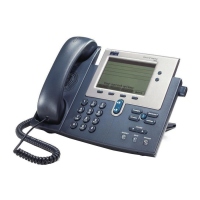1-4
Cisco Unified IP Phone 7960G/7940G Administration Guide for Cisco Unified Communications Manager 7.0 (SIP)
OL-15499-01
Chapter 1 An Overview of the Cisco Unified IP Phone
What Networking Protocols Are Used?
What Networking Protocols Are Used?
Cisco Unified IP Phones support several industry-standard and Cisco networking protocols required for
voice communication.
Table 1-1 provides an overview of the networking protocols that the
Cisco Unified IP Phone 7960G and 7940G support.
Ta b l e 1-1 Supported Networking Protocols on the Cisco Unified IP Phone
Networking Protocol Purpose Usage Notes
Bootstrap Protocol
(BootP)
BootP enables a network device such as the
Cisco
Unified IP Phone to discover certain
startup information, such as its IP address.
If you are using BootP to assign IP addresses to
the Cisco
Unified IP Phone, the BOOTP Server
option shows “Yes” in the network configuration
settings on the phone.
Cisco Discovery
Protocol (CDP)
CDP is a device-discovery protocol that runs
on all Cisco-manufactured equipment.
Using CDP, a device can advertise its existence
to other devices and receive information about
other devices in the network.
The Cisco Unified IP Phone uses CDP to
communicate information such as auxiliary VLAN
ID, per port power management details, and Quality
of Service (QoS) configuration information with the
Cisco Catalyst switch.
Dynamic Host
Configuration Protocol
(DHCP)
DHCP dynamically allocates and assigns an IP
address to network devices.
DHCP enables you to connect an IP phone into
the network and have it become operational
without you needing to manually assign an IP
address or configure additional required
network parameters.
DHCP is enabled by default. If disabled, you must
manually configure the IP address, subnet mask,
gateway, and a TFTP server on each phone locally.
Cisco recommends that you use DHCP custom
option 150. With this method, you configure the
TFTP server IP address as the option value. For
additional supported DHCP configurations, refer
Cisco Unified
Communications Manager System
Guide.
Hypertext Transfer
Protocol (HTTP)
HTTP is the standard way of transferring
information and moving documents across the
Internet and the web.
Cisco Unified IP Phones running SIP support
HTTP as a client protocol.
Internet Protocol (IP) IP is a messaging protocol that addresses and
sends packets across the network.
To communicate using IP, network devices must
have an assigned IP address, subnet, and gateway.
IP addresses, subnets, and gateways
identifications are automatically assigned if you
are using the Cisco
Unified IP Phone with
Dynamic Host Configuration Protocol (DHCP). If
you are not using DHCP, you must manually
assign these properties to each phone locally.
Real-Time Transport
(RTP)
RTP is a standard protocol for transporting
real-time data, such as interactive voice and
video, over data networks.
Cisco Unified IP Phones use the RTP protocol to
send and receive real-time voice traffic from other
phones and gateways.
Session Description
Protocol (SDP)
SDP is the portion of the SIP that determines
which parameters are available during a
connection between two endpoints.
Conferences are established using only the
SDP capabilities that are supported by all
endpoints in the conference.
SDP capabilities, such as codec types, DTMF
detection, and comfort noise are normally
configured on a global basis by the
Cisco
Unified Communications Manager or the
Media Gateway in operation. Some SIP endpoints
may allow these parameters to be configured on
the endpoint itself.

